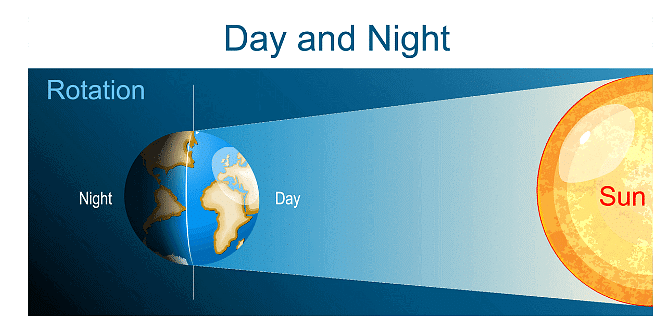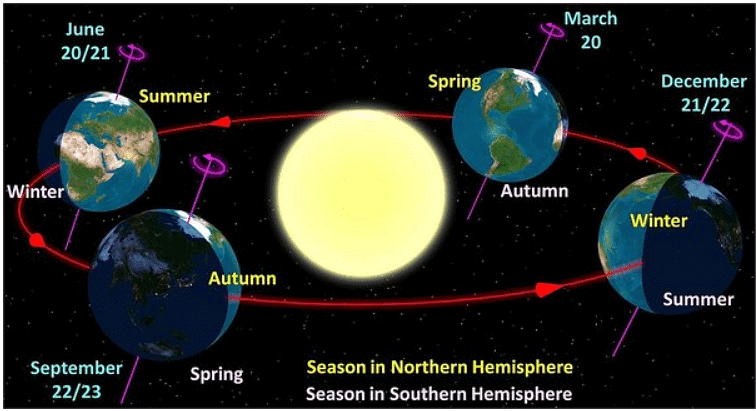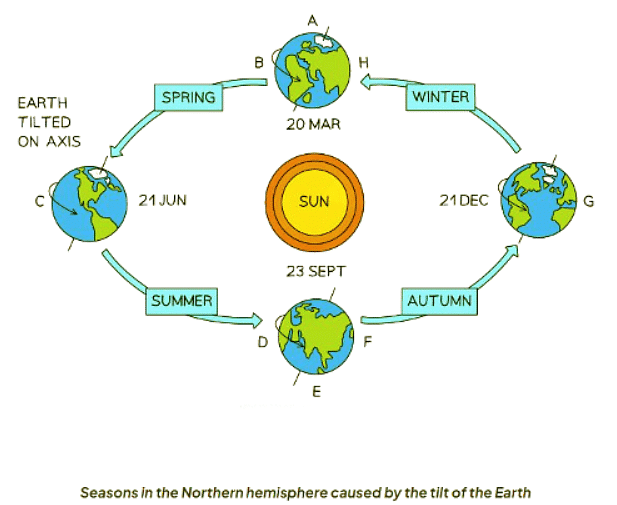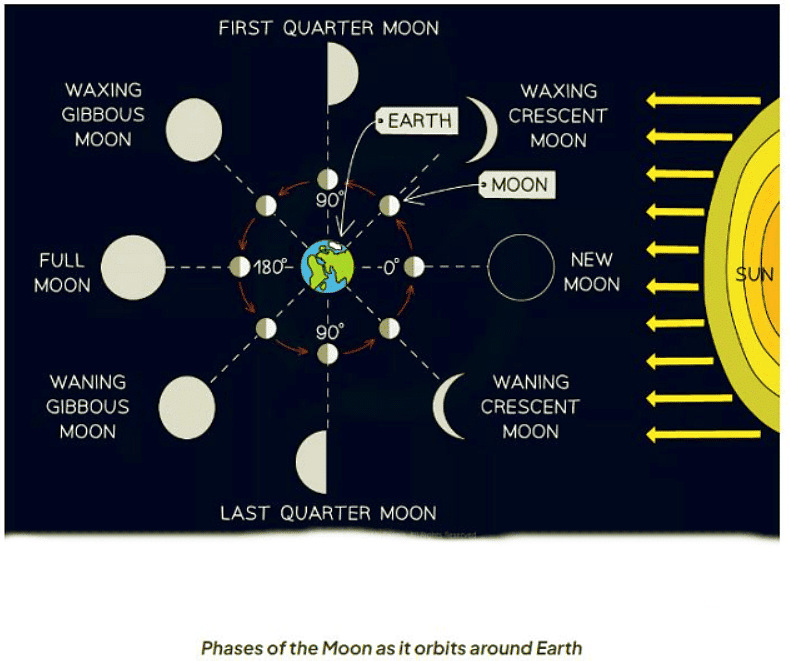The Earth, Moon & Sun | Physics for GCSE/IGCSE - Class 10 PDF Download
The Earth's Axis
- The Earth orbits the Sun in a nearly circular path.
- Rotation occurs on an axis passing through the north and south poles, tilted at about 23.5 degrees from the vertical.
- It takes approximately 24 hours for the Earth to complete one full rotation, equivalent to a day.
Rotation of the Earth and Day-Night Cycle
- The rotation of the Earth on its axis is responsible for the daily motion of the Sun, creating the cycle of day and night.
- This rotation causes the Sun to appear to rise and set, leading to the regular occurrence of day and night.
Periodic Cycle
- The Earth's rotation around its axis is the fundamental reason behind the occurrence of day and night.
- During daylight, one half of the Earth faces the Sun, experiencing day, while the other half faces away, resulting in night.
Understanding Day and Night
- Daytime is experienced by the part of the Earth illuminated by the Sun, while nighttime occurs on the opposite side facing away from the Sun.

Rising and Setting of the Sun
- Earth's Rotation and Sun's Movement
- The Earth's rotation on its axis creates the illusion of the Sun moving from east to west.
- Equinoxes: Equal Day and Night
- During equinoxes, the Sun rises directly in the east and sets directly in the west, leading to approximately equal lengths of day and night.
- Equinox, derived from "equal night," signifies this balance.
- Seasonal Changes
- Throughout the seasons, the specific points where the Sun rises and sets vary.
Regional Variances
- In the Northern Hemisphere
- In summer, the Sun rises north of east and sets north of west.
- In winter, the Sun rises south of east and sets south of west.

The Sun rises in the east and sets in the west. Its approximate area changes throughout the year.
- The Sun is highest above the horizon at noon (12 pm)
- In the northern hemisphere, the daylight hours are longest up until roughly the 21st June. This day is known as the Summer Solstice and is where the Sun is at its highest point in the sky all year.
The daylight hours then decrease to their lowest around 21st December. This is known as the Winter Solstice and is where the Sun is at its lowest point in the sky all year.
Summer Solstice
- This day is known as the Summer Solstice and is where the Sun is at its highest point in the sky all year.
Winter Solstice
- The daylight hours then decrease to their lowest around 21st December. This is known as the Winter Solstice and is where the Sun is at its lowest point in the sky all year.
The Winter Solstice, also known as the December Solstice, marks the shortest day and longest night of the year in the Northern Hemisphere. It occurs when the Sun is at its lowest point in the sky, resulting in the least amount of daylight.
The Earth's Orbit
- The Earth completes one orbit around the Sun in about 365 days, which we define as a year. This orbital journey, combined with the tilt of the Earth's axis, is responsible for the changing seasons we experience.
- The tilt of the Earth's axis is crucial in creating the seasons. As the Earth orbits the Sun, different parts of the Earth receive varying amounts of sunlight, leading to the distinct seasons we observe.

The Earth's Orbit and Seasons
- Spring and Summer:
- During parts B, C, and D of the orbit, the northern hemisphere is tilted towards the Sun.
- This results in longer daylight hours than darkness, marking the season of spring and summer.
- Autumn and Winter:
- Conversely, in spring and summer, the southern hemisphere is tilted away from the Sun.
- Shorter days than nights occur during this period, indicating the arrival of autumn and winter.
- Reversed Hemispheres:
- Over parts F, G, and H of the orbit, the northern hemisphere tilts away from the Sun.
- This scenario leads to a reversal of seasons between the northern and southern hemispheres.
- While it is autumn and winter in the northern hemisphere, it is spring and summer in the southern hemisphere.
- Equinoxes and Solstices:
- At points A and D, day and night are equal in both hemispheres, representing the equinoxes.
- During the summer solstice at point C, the northern hemisphere experiences its longest day, while the southern hemisphere has its shortest day.
- Conversely, at the winter solstice at point G, the northern hemisphere has its shortest day, while the southern hemisphere enjoys its longest day.
Seasonal Changes on Earth
- Summer Solstice: The summer solstice marks the point at which the northern hemisphere receives the most sunlight, resulting in the longest day of the year for this region. Conversely, the southern hemisphere experiences its shortest day during this time. This occurrence is pivotal in various cultures and is often associated with celebrations and festivals to honor the abundance of light and warmth.
- Winter Solstice: The winter solstice signifies the period when the northern hemisphere receives the least amount of sunlight, leading to its shortest day of the year. In contrast, the southern hemisphere enjoys its longest day during this season. Many traditions and customs worldwide observe the winter solstice as a time of rebirth, renewal, and the eventual return of longer days.
- Equinoxes: Equinoxes, which happen twice a year, occur when day and night are approximately equal in duration all over the world. This balance is a result of the Earth's axial tilt and its orbit around the sun. The vernal (spring) and autumnal equinoxes hold cultural significance, symbolizing harmony, balance, and the cyclical nature of life.
Moon & Earth
- The Moon, Earth's natural satellite, orbits our planet in a circular path once every month. This journey takes approximately 27-28 days.
- Due to synchronous rotation, the Moon consistently presents the same face to Earth. As a result, we never witness the side that perpetually faces away from us. Notably, astronauts and satellites have captured images of this hidden hemisphere.
- The Moon's luminosity emanates from sunlight reflection rather than intrinsic light production.
The Periodic Cycle of Moon Phases
- The Moon undergoes a periodic cycle of phases, which refers to the way its appearance changes over the course of a month when observed from Earth.

- The inner circle in the image illustrates that exactly half of the Moon is illuminated by the Sun at all times.
- The outer circle shows how the Moon appears from Earth at different positions.
Moon Phases Explained:
- New Moon Phase: During this phase, the Moon is positioned between the Earth and the Sun. Consequently, sunlight only illuminates the side of the Moon opposite to the Earth. This results in the Moon being unlit and invisible from Earth.
- Full Moon Phase: At this stage, the Earth lies between the Moon and the Sun. The side of the Moon facing Earth is entirely lit by sunlight, making it appear fully illuminated from our perspective.
- Crescent Phase: Between the New Moon and Full Moon phases, a crescent shape can be observed where the Moon is partially lit by sunlight, creating a visible crescent shape.
The Earth, Moon & Sun
- The Moon is positioned between the Earth and the Sun, resulting in sunlight only reaching the side opposite to Earth. Consequently, the Moon appears unlit from our perspective and remains invisible.
- During a Full Moon phase, the Earth is situated between the Moon and the Sun. This positioning causes the side of the Moon facing Earth to be fully illuminated by sunlight, making it appear fully lit from Earth.
- Intermediately, a crescent shape can be observed when the Moon is partially illuminated by sunlight.
|
126 videos|148 docs|35 tests
|
FAQs on The Earth, Moon & Sun - Physics for GCSE/IGCSE - Class 10
| 1. How does the Earth's axis affect the changing seasons? |  |
| 2. What causes the phases of the Moon? |  |
| 3. How does the Earth's orbit affect the length of a year? |  |
| 4. How does the Moon's gravitational pull affect the Earth? |  |
| 5. How does the alignment of the Earth, Moon, and Sun impact eclipses? |  |





















